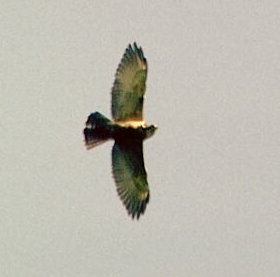|
Broad-winged Hawk Buteo platypterus Guaraguao de Bosque, |
 |
|
Photo: A. Sánchez Muñoz
|
|
IDENTIFICATION: A medium-sized forest hawk; it is brown above, and light rufous below, with white wing linings visible in flight. The tail is boldly barred with broad, black and white bands. Length: 34-44 cm.; weight: 265-550 g.; wingspan 86-100 cm. The female is slightly larger than the male. The Puerto Rican subspecies (Buteo platypterus brunnescens) falls in the smaller size range for the species. VOICE: A prolonged, rising whistled note. Audio (M. Oberle). HABITAT: Currently found only in a few isolated mountain areas in both natural and plantation forests. HABITS: Prefers to hunt from a perch under the forest canopy that offers a clear view of a forest clearing, trail, river, or road. It also flies just above the forest canopy hunting for frogs, lizards, birds, large insects, and centipedes. Each pair requires a home range of about 40 hectares. The Broad-winged Hawk typically builds its stick nest in February and March and lays 2-4 white eggs with brown splotches. The female incubates the eggs for 28-31 days, while the male hunts for food. After hatching, the larger chick in a clutch may try to kill the smaller chicks. The young fledge in April and May about 29-31 days after hatching and can fly well about six weeks after hatching. The parents feed the young birds for the first few weeks after leaving the nest. STATUS AND CONSERVATION: Common in North America, but the subspecies in Puerto Rico is on the federal endangered species list, with a total estimated population of only 124 individuals in 1992. This bird was common in the mid-19th Century, but had become so rare that some biologists thought it extinct in Puerto Rico by the early 20th Century. In the Caribbean National Forest (El Yunque), Broad-winged Hawks declined by 50% from 1984 to 1992. Illegal hunting and forest destruction due to construction of roads, power lines, and communication facilities are threats to this species. Due to the small, isolated populations of this species, major disasters---such as a large hurricane---and the hawk’s reduced genetic diversity, are potential threats. Protection of nest sites and coordination of forest management to protect and enhance the hawks’ forest habitat is essential. Ironically, Wetmore in the early 20th Century cited the Spanish name "Guaraguou de Sabana" for this species. The Broad-winged Hawk may well have been the "Hawk of the Savannah" at one time, but habitat destruction in the lowlands has forced the species from the forested coastal plain into a few remaining mountain holdouts. RANGE: Breeds in North America, and the West Indies where four other subspecies occur on other islands. North American populations migrate for the winter to southern Florida and Guatemala, south to southern Peru and Brazil. The endemic subspecies in Puerto Rico is essentially found only in three forest areas: Río Abajo and Carite State Forests; and Caribbean National Forest. The highest density in recent surveys has been in the Río Abajo State Forest. Although it can occasionally be seen soaring, the hawk’s preference for hunting from a perch or gliding low over the forest canopy makes it difficult to detect. TAXONOMY: FALCONIFORMES; ACCIPITRIDAE; Accipitrinae |
 |
|
Photo: W. Arendt*
|
 |
|
Photo: J. Hornbuckle
|

